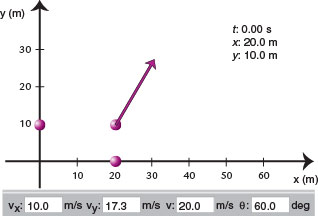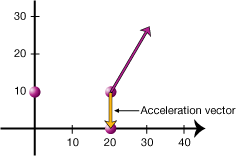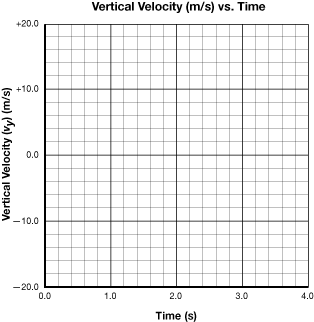Module 2—Motion in Two Dimensions
 Lesson 4 Lab: Projectile Motion—One Ball Simulation
Lesson 4 Lab: Projectile Motion—One Ball Simulation
Introduction
The simulation used in this lab shows the path of a ball being thrown on Earth. This is a simulation of the projectile motion of a ball without air resistance, where the acceleration is only due to gravity. You can learn more about the simulation and how to use it by reading the Show Me found at the top of the simulation screen.
Problem
Are the vertical and horizontal motions of a projectile independent from one another?
Open the Projectile Motion: One Ball simulation; then continue with the procedure.
Procedure

Figure 1
The simulation will be used to show the motion of a simple projectile with no air resistance.
- Click the “Reset” button (
 ).
).
- Position the ball at (x, y) = (20.0 m, 10.0 m) by clicking on it and dragging it to that position. Click the “Data” button to see your coordinates displayed.
- Set the initial velocity to a magnitude of 20.0 m/s (in the third box at the bottom of the screen). Direct the velocity at an angle (θ) of 60.0° relative to the positive x-axis (in the fourth box at the bottom of the screen). Press “Enter” on your keyboard. The simulation should be configured as shown in Figure 1.
- Click “Play” (
 ). The ball will be moving without air resistance. View the motion several times by clicking the “Rewind” button (
). The ball will be moving without air resistance. View the motion several times by clicking the “Rewind” button ( ).
).
- Click the “Vectors” button (
 ), and observe the acceleration vector by selecting the acceleration square. Sketch and label the acceleration vector on Figure 1.
), and observe the acceleration vector by selecting the acceleration square. Sketch and label the acceleration vector on Figure 1.
- Click “Play” (
 ). View the motion several times by clicking the “Rewind” button (
). View the motion several times by clicking the “Rewind” button ( ).
).
Acceleration Vector Sketch from Procedure

Observation and Analysis
 Module 2: Lesson 4 Assignment
Module 2: Lesson 4 Assignment
Remember to submit the answers to LAB 1, LAB 2, and LAB 3 to your teacher as part of your Module 2: Lesson 4 Assignment.
LAB 1. What is the ball's acceleration on the way up, at the top, and on the way down?
____________ m/s2
You should be able to observe that the acceleration vector remains constant throughout the motion, both in magnitude and direction. In particular, it is not zero at the peak of the motion.
LAB 2. Click “Rewind” (![]() ), and change the ball's initial velocity to a magnitude of 40.0 m/s and to a direction that forms an angle (θ) with the positive x-axis equal to 50.0°. Press “Play,” and observe the acceleration vector. Did the acceleration vector change when you entered the new initial velocity, and does it vary during the new motion? Explain why the answers to both questions are the same.
), and change the ball's initial velocity to a magnitude of 40.0 m/s and to a direction that forms an angle (θ) with the positive x-axis equal to 50.0°. Press “Play,” and observe the acceleration vector. Did the acceleration vector change when you entered the new initial velocity, and does it vary during the new motion? Explain why the answers to both questions are the same.
LAB 3. Change the ball's initial velocity to a magnitude of 20.0 m/s and to a direction that forms an angle (θ) with the positive x-axis equal to 90.0°. Press “Play,” and observe the straight up-and-down motion.
- Does the acceleration ever become zero?
- Does the velocity ever become zero? If so, where in the projectile path does this occur?
- Does a zero velocity imply that no acceleration is acting? Explain.
LAB 4. Position the ball at (x, y) = (20.0 m, 10.0 m) and set the initial velocity to a magnitude of 20.0 m/s. Direct the velocity at an angle (θ) of 60.0° relative to the positive x-axis, and press “Play”. Observe the horizontal velocity component (vx). Does it change throughout the motion? Based on this observation, is there a horizontal acceleration? Remember to add this answer to your course folder.
Hint: The shadow ball on the horizontal axis moves with constant velocity. Thus, there is no horizontal acceleration. However, there is vertical acceleration. The shadow ball on the vertical axis moves up and then down and does not move with constant velocity.
 Module 2: Lesson 4 Assignment
Module 2: Lesson 4 Assignment
Remember to submit the answer to LAB 5 to your teacher as part of your Module 2: Lesson 4 Assignment.
LAB 5. Determine the vertical acceleration by plotting and calculating the slope of the vertical velocity-time graph. Set the step slider (![]() ) to a time step of size 0.50 s. If you can’t get the slider to drag to the exact value, click the button (#) next to the step slider and type 0.50 s. Then press “Rewind” (
) to a time step of size 0.50 s. If you can’t get the slider to drag to the exact value, click the button (#) next to the step slider and type 0.50 s. Then press “Rewind” (![]() ).
).
- Step through the motion by repeatedly pressing the “Step” button (
 ), and record the vy component of the velocity in Table 1.
), and record the vy component of the velocity in Table 1.
t (s) vy (m/s) 0.0
______ 0.5
______ 1.0
______ 1.5
______ 2.0
______ 2.5
______ 3.0
______ 3.5
______
- Plot vertical velocity (vy) versus time on the following graph.

- Calculate the slope of the line for the vertical velocity-time graph. Include the units for velocity and time, and, using the units, prove that the slope must be equal to the vertical acceleration.
Lab Summary
The ball's acceleration in the x direction is 0 m/s2, and in the y direction it is –9.81 m/s2. This is written using component notation as follows:
ax = 0 m/s2, ay = –9.81 m/s2
The vertical acceleration is called the acceleration due to gravity because it is caused by gravity alone. This result allows the following description of projectile motion in terms of the motions of two shadow balls (one moving on the horizontal axes and another moving on the vertical axes).
The motion of the horizontal shadow ball is motion with constant velocity.
The motion of the vertical shadow ball is motion with constant acceleration. The acceleration of the shadow ball moving on the vertical axis is downward and, on earth, has magnitude g = –9.81 m/s2.